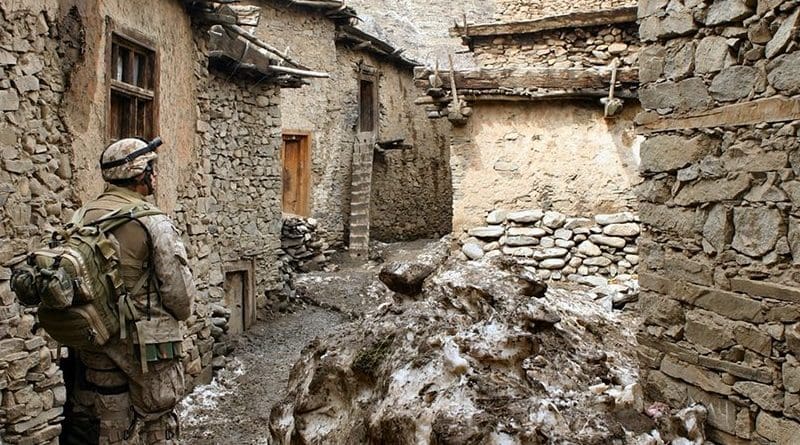The Cost And Economic Consequences Of The War In Afghanistan – Analysis
By Musa Shafiq*
When NATO and an international coalition became engaged in the Afghanistan War, the hope was that the intervention would lead to a quick cessation of conflict. Unfortunately, that did not occur.
Since 2001, the war with the Taliban and Al-Qaeda has cost Afghanistan millions of dollars and thousands of lives. The conflict kills more than one hundred soldiers, police officers, and civilians every day. It has overwhelmed the infrastructure, depleted resources, and devastated the economy. Worst of all, there is no clear path to the end of the war. The only thing that is clear is the ongoing human tragedy and worsening economic conditions.
The Human Cost of War
According to the Watson Institute at Boston University, 111,000 people were killed from 2001 to 2015. According to Afghan officials, another 28,592 soldiers and police officers were killed from 2015 to 2018. Additionally, the New York Times estimated that every day, on average, the war kills 25 soldiers and police officers in Afghanistan.
There is also a heavy toll paid in civilian injuries. A study by Bethany Lacina, a professor at Stanford University, and Nils Petter Gleditsch, a researcher at the International Peace Research Institute in Oslo, projected that the number of battle deaths is less than 10% of the total deaths. The casualties are not limited to those killed in the combat; there are also serious injuries that lead to death, uninvolved civilians killed, and diseases that result from the war, gradually killing many more.
If we were to quantify the human cost of war in Afghanistan using the Lacina and Gleditsch’s model and the figures above, the results would be 250 casualties a day or 1750 a week. These figures are unfortunately consistent with the official statics. For example, only in one day, in a suicide attack in November 2018, more than 50 people were killed and more than 80 were seriously wounded in the city of Kabul. In another suicide attack in Nangarhar Province in September 2018, around 68 were killed and more than 168 were injured. These two figures are only from single incidents in a single city. However, if one counts the total of casualties from all over the country, this approach might even lead to a higher number.
The Afghan officials also acknowledge these projections. Recently, President Ghani stated that every day, war takes the lives of 100 to 200 citizens. By recognizing this tragedy, he pledged to make any commitment that would end the war and lead to stability and prosperity.
The Economic Cost of War
In addition to the human cost of war, the economic cost is also tremendously high. Though there are no exact statistics on the economic cost of the war in Afghanistan, it can be estimated by using the research on other parts of the world.
For instance, Paul Collier and Anke Hoeffler, professors of economics at Oxford University, have estimated the total economic cost of war is equivalent to 105% of a country’s GDP. Applying this model to the $20.815 billion GDP of Afghanistan, the total economic costs of war lead to $60 million a day, $455.33 million a week, $1821.33 million a month, or a total of $21,856.07 million a year. For a country like Afghanistan, which has a development budget of 1.6 billion, and more than $200 million deficit, these costs are devastating.
War and Economic Growth
When experts debate the relationship between war and economic growth, it becomes a debate much like the chicken or the egg. Which comes first? Does a country need to achieve peace first to achieve economic growth, or should it experience economic growth first to end war? However, one thing is clear, and that is the negative impact of war on growth and investment.
According to research from the World Bank in Africa, war-affected countries have, on average, 50% lower incomes compared to countries not at war. The report also concluded that countries at war experienced a 50% lower investment ratio.
These negative impacts of war are obvious on the economy of Afghanistan. Currently, the country suffers with a GDP per capita of only $585.85, which ranks among the poorest countries. Making matters worse is the analysis by Afghanistan’s Chamber of Commerce that shows foreign investments have dropped to their lowest level in 2018, and overall investments have declined by 26%.
Consequences of War
Every moment, the economic consequence of war increases significantly. For countries involved in war, it takes years or even decades to regain their pre-war economic growth and prosperity. A study shows that it takes almost 21 years for a country trapped in war to achieve the level of GDP that would have been attained if the country were not involved in war.
The consequences of war have been significant, both in terms of human suffering as well as the economy. Every day hundreds of people are killed and the resulting cost to the economy is millions of dollars. In plain words, the daily economic costs of war for Afghanistan are an estimated $60 million and 250 human casualties. Furthermore, each year of war hamper economic growth that requires another 21 years of struggle and suffering to regain the pre-war economy.
Considering the devastating cost, Afghan elites should do their best to end the war. Otherwise, every day it will cost millions of dollars and hundreds of human lives.
About the author:
*Musa Shafiq, Associate Professor of Economics at Kabul University, currently pursuing Ph.D. in Economic at Strasbourg University, France. His research interest is political economy with focus on the institution

